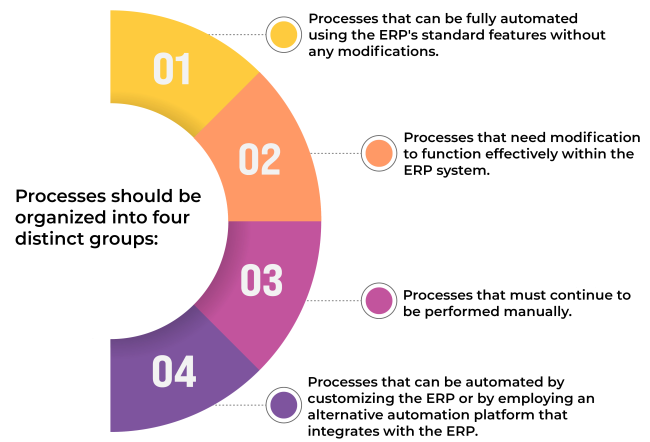A Strategic Guide To Automation And Efficiency During ERP Deployment
Before adopting a new ERP platform like SAP, or incorporating newly acquired entities into an existing ERP framework, businesses must undertake a thorough process rationalization exercise. This critical step ensures that only essential processes are retained or optimized, safeguarding operational efficiency and strategic alignment during the integration phase.
After identifying the essential processes required to operate your business, you can begin categorizing these processes.

Categorize Processes For Automation
For the first two categories—processes that can be automated using the ERP’s standard features and those requiring modifications for ERP compatibility—you must determine the implementation sequence within the ERP roadmap. Given that ERP implementations, such as SAP, can extend over several years, it’s important to recognize that some processes destined for ERP integration may temporarily fall into the third and fourth categories. This means they might remain manual or require alternative automation solutions until they can be fully incorporated into the ERP system.
For processes initially deemed to require manual execution, there may be opportunities for partial automation or, at the very least, automating the oversight of manual tasks. Consequently, these could also be classified under category 4, where processes are candidates for future automation or customization. Manual processes will remain untouched by automation until there’s a compelling reason for change. Such a shift typically occurs naturally when the resources needed to manage these processes become unsustainable, or when they excessively divert skilled workers from more strategic, high-value activities.
The 4th category is the most fun! As mentioned above, processes from categories 1, 2, and 3 might also fall into this category under certain circumstances. This category encompasses processes that are earmarked for automation, either through ERP customization or by leveraging an alternative platform. Such processes often involve numerous exception flows, each justified by its unique business value. Additionally, these processes typically require a higher degree of customization due to their deviation from standard procedures, underscoring their complexity and the tailored approach needed for automation.
How To Immediately Automate Processes That Can’t Be Automated With The ERP’s Standard Features
When deciding whether to customize an ERP system or to utilize an alternative platform, the key factors to consider are the development and maintenance costs, as well as the time required to launch the solution. This is where low-code automation platforms, such as Workato, become highly advantageous. Rather than navigating the complexities of customizing a robust system like SAP, integrating Workato automation with SAP allows for straightforward automation development within Workato itself. This approach significantly accelerates the process, enabling the transition from defining business processes and rules to activating live automation in just days or weeks. In contrast, undertaking similar customizations directly in SAP would take considerably longer, making the use of platforms like Workato not just faster, but exponentially so.
We consider iPaaS solutions (like Workato) as accelerators, allowing users to maintain business functions with live software during the phased rollout of systems like SAP. Here are some examples:
- Avoid Delayed Implementation
Automate smaller, distinct workflows and edge cases, efficiently linking them to the core functionalities being rapidly deployed on the ERP platform.
- Eliminate Duplicative Work
By cleanly transferring data between the legacy system and the new ERP during deployment, users need to input data into only one system — either the new or the legacy — avoiding the necessity for duplicate entries.
- Cut Out Manual Data Exports
The automatic extraction and merging of data from both systems eliminates the need for users to manually export data from the new and old systems into Excel for the data to be manipulated. Workato can often automate these tasks even further, enhancing efficiency and productivity!
How Much Time Can You Save With An iPaaS Solution?
Deploying an ERP system may be a multi-year journey, but this doesn’t mean your teams must fall back on manual tasks and double data entry in the meantime. With an iPaaS solution like Workato, you can secure quick wins, streamlining processes either as lasting solutions or temporary fixes until the ERP implementation is complete.



